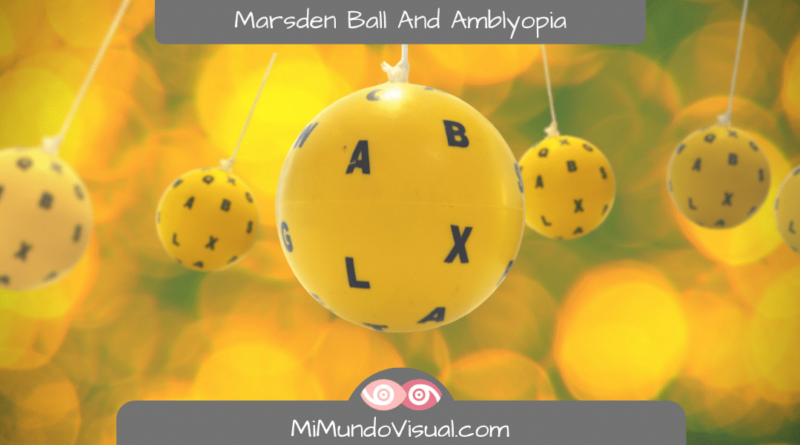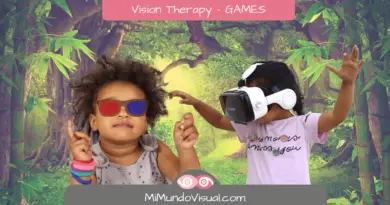Marsden Ball And Amblyopia
Table Of Contents
Vision Therapy Exercises
- Eccentric Circles
- Lifesaver Cards For Convergence And Divergence
- Mazes as Vision Therapy Exercises!
- Brock String
- Marsden Ball
- 5 Activities To Do While Wearing An Eye Patch
- Lazy Eye – 5 Games And Activities For Adults
Download Our Lazy Eye Guide!
The Marsden Ball, although at first glance it looks like a simple little ball, is a tool used in vision therapy to treat amblyopia, among other things.
With this article, we will learn what the Marsden ball and its uses are. How we can rely on it when treating amblyopia. We will finish with a series of exercises to practice at home.
What is the Marsden Ball?
The Marsden ball is a rubber ball slightly larger than a tennis ball, which is connected to a string so that it can be hung.
Depending on the use case, the ball may have letters, numbers, colors, patterns, or a combination.
What is the Marsden Ball used for?
The purpose of using the Marsden ball is to train saccadic movements as well as accommodation and is used to treat:
- Amblyopia (or lazy eye)
- Strabismus
- Difficulty with visual tracking skills
- Hand-eye coordination difficulties
- Difficulty in using both eyes together
- Difficulty in visual-spatial processing
- Traumatic brain injury
Marsden Ball To Treat Amblyopia
The letters are usually black, but for amblyopia vision therapy exercises, the letters can also be in red.
In this case, a red filter patch is put over the dominant eye so that the red letters will only be seen by the amblyopic eye.
The Marsden Ball is used in Sports Training.
The Marsden ball can also help athletes improve their performance, as it helps improve coordination, hand-eye tracking, and peripheral vision.
The Marsden ball is a good exercise for identifying where the ball is going to land, which is why it is used for ball sports such as baseball and golf.
Use cases for using Marsden Ball Exercises?
Marsden Ball exercises are designed for any person, child, or adult who needs to improve efficiency and precision in hand-eye coordination, specifically in the ability to follow a moving target and to change the point of fixation from one target to another (saccadic movements).
As well as for people who need to improve their binocular vision by fixing both eyes on the same target using both eyes equally and simultaneously.
Thanks to the Marsden ball, we can treat problems of general clumsiness, lack of balance and coordination, or lack of ability to catch moving objects.
In addition to treating tracking problems, it can also be helpful for people with reading issues. In particular, help those people needing the use their finger as a guide to read.
What Is The Origin Of The Marsden Ball?
The Marsden ball was devised by optometrist Carl D. Marsden in the late 1940s with the idea of being able to practice eye exercises at home as well.
Marsden Ball Exercises
Exercise 1: Marsden's Ball
We place the ball at the height of our eyes while it is hanging on its string. We can tie it to hang from the ceiling, a lamp, or furniture or ask someone to hold it.
We can lie on the floor (easiest position), sit or stand.
We cover one of our eyes with an eye patch, we move the ball so that it moves from right to left, and we follow the movement of the ball with our eye without moving our head. We only move our eye.
Suppose this is a difficult task to accomplish. In that case, we can use our index finger to follow the ball’s movement more easily by pointing to it with our fingers.
The purpose of this exercise is to train eye movements. If we want to practice accommodation at the same time, we’ll follow the ball with our eye and read the letters that appear in the ball randomly.
Then, we will change the eye patch and repeat the exercise with the other eye. Finally, we will repeat each step with both eyes together in order to train our binocular vision.

Exercise 2: Marsden Ball and Balance Board
We place the ball in front of us, get on a balance board, and keep our eyes on the motionless ball. Once we have it under control, we can push the ball and follow the ball’s movements while on the balance board. We keep our balance without moving our heads and follow the Marsden Ball with smooth eye movements.
We can also use a small trampoline; if we do not have one, we can do it standing on one leg. First, we raise one foot, keep in balance with one foot, and then we change feet.
Exercise 3: Marsden Ball And Bat Or Stick
We will also need a bat, stick or any other suitable substitute for this exercise.
The aim is to gently hit the ball with the bat in a controlled movement. This will allow us to develop hand-eye coordination and learn how to predict where objects will likely be.
In turn, we can also set a fixed point in front of us, a target to aim at. It can be a sheet of paper with a letter or symbol in the center so that when we hit the ball with our stick, the Marsden Ball covers the fixation point we have chosen (the central letter or symbol on the sheet is placed in front of us).
If we want to add complexity, we can add additional targets and hit one of the chosen fixed points each time.

Exercise 4: Marsden Ball And Colored Stick
Now we can paint sections of the stick we had in different colors or use adhesive tapes of various colors.
We hold the stick the same way as in the previous exercise, horizontally with the fingertips down and hitting the ball with different stick colors.
We can also skip colors. Let’s imagine that we have chosen the colors red, yellow, and green: we hit the red twice and randomly change color to yellow three times and once with the green color, for example,
We can also work laterally, combining left and right.
As we hit the letters each time, we will name which letter we hit.
We must consult our optometrist first if these exercises with the Marsden ball suit our case and our current situation.
More About Amblyopia or Lazy Eye
- How Do I Know If I Have A Lazy Eye?
- What Causes Amblyopia Or Lazy Eye?
- How To Detect A Lazy Eye?
- What is Amblyopia?
- 6 Eye Patch Therapy Inconveniences We Are Not Told About
- How To Choose The Best Eye Patch For My Child?
- Contact Lenses For Children With Lazy Eye!
- 5 Questions About Lazy Eye In Adults!
- Lazy Eye In Adults – Little Everyday Difficulties That May Be Due To Amblyopia!




